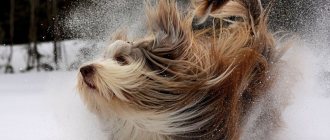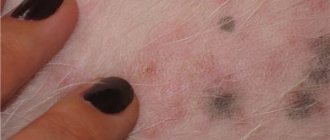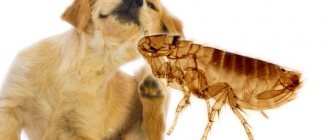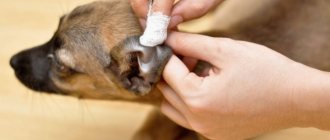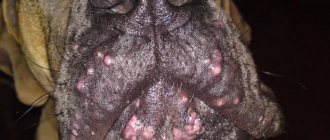Inflammatory skin diseases, manifested in the form of pimples or blackheads, are usually called by the general definition - acne. They are found not only in people, but also in four-legged pets. And if a person is sometimes more concerned about the fact that acne negatively affects one’s appearance, then for an animal, the discomfort caused by the inflammatory process causes greater suffering.
Dogs scratch pimples and thereby only make things worse, as the infection penetrates deeper into the layers of the skin and increases inflammation. In addition, the pustules get wet when the dog drinks water, which slows down the healing process.
What do rashes look like?
Pimples on the face of dogs look like white or red bumps. They can be single, but often cover fairly large areas of the skin. Red rashes indicate inflammation, and whiteheads are a sign of suppuration.
Sometimes you can notice black pimples on a dog's chin. They look like little dots. These rashes appear due to clogged pores and are similar to human comedones. The appearance of blackheads most often indicates insufficient hygiene of the animal or an excess of fatty foods on the menu.
A photo of acne on a dog's face can be seen below. To understand the reasons for their appearance, you need to take a good look at the rashes and pay attention to your pet’s behavior.
High-risk groups: which dogs get sick more often?
Some of the most acne-prone breeds are the pug and the beagle.
Some dog breeds, due to the characteristics of their biological structure, are more genetically predisposed to developing acne than others:
- with “wrinkled” skin - Shar-Pei, English Bulldogs, Pugs, Neapolitan Mastiffs (Mastino Neapoletano), Bullmastiffs, Basset Hounds, Dogues de Bordeaux;
- with webbed feet - Newfoundlands, Landseers, Portuguese Wasserhunds (Can-Diagua), Weimar pointers (Weimaraners), Otterhounds, Chesapeake Bay retrievers, German shorthaired pointers (shorthaired pointers);
- with smooth hair (smooth-haired) - dachshunds, toy terriers, Italian greyhounds, English greyhounds (greyhounds), pointers, bull terriers, Argentinean (Dogo-Argentino) and Great Danes, Dobermans, boxers;
- with residual fur (hairless) - Peruvian Inca dogs (viringo, calato), Chinese crested, Mexican hairless (xoloitzcuintle, xolo), American hairless terriers;
- with thick undercoat - Scottish (collie) and Caucasian shepherd dogs, Pekingese, chow-chow, Spitz, Samoyed huskies (Samoyeds), Bernese Mountain dogs, Tibetan mastiffs.
In the case of dogs with a very dense undercoat, the relevance of the concerns directly depends on the conditions of their keeping: if they constantly live in a hot, windless climate, then it is almost impossible to avoid the occurrence of inflammation.
Video - Skin diseases in dogs
Important! In male dogs castrated at an early age, the risk of developing “adult” acne increases many times over.
In outbred dogs (mongrels and mixed breeds), even when kept outdoors (in a kennel or enclosure), acne is extremely rare.
Acne
Veterinarians use the word “acne” to describe all types of acne. The rash most often covers the chin, cheeks and lips. It is in these areas that a large number of sebaceous glands are located. Their ducts often become blocked and infected.
Acne can be a separate disease. The reason for its appearance is the following factors:
- Hormonal changes. Acne appears in puppies during the period of active growth and maturation. In adult dogs, acne can occur due to temporary hormonal imbalances.
- Features of the breed. Boxers, Pugs and Bulldogs are prone to developing rashes. Pimples on the lips are a common occurrence in dogs of these breeds. Dogs with a short muzzle are characterized by increased salivation. Their lips constantly get wet, and a humid environment promotes the growth of bacteria and fungi.
- Skin wounds. Even minor injuries (cuts, bites, splinters) can become a gateway for germs to enter.
However, acne very rarely occurs as an independent pathology. There are many skin and internal diseases that cause acne on the face of dogs. We will look at the causes of acne below.
Cornea problems
If pinpoint opacities are noticeable inside the eye, we are talking about damage to the cornea. In particular, keratitis, its inflammation, is common in pugs.
Superficial or pigmentary keratitis manifests itself in the appearance of ulcers, clouding, redness and pain.
This disease can occur as a result of external influences on the eyes. In addition, there is pigmentary keratitis, which appears as an overgrowth of pigment in the eye.
Most often, superficial keratitis leaves no marks on the eye. Pigmentary keratitis is treated with surgery and a number of topical medications, such as eye drops.
Keratitis, including pigmentary keratitis, can be one of the types of severe allergies in a pug.
In such cases, the most appropriate treatment is anti-allergy medications.
Pyoderma
Pyoderma is a purulent skin disease caused by staphylococci. The pathological process develops gradually. First, pimples form on the dog's face. They may appear as pustules, red bumps, or acne with a scaly texture. It is advisable to begin treatment when the first rash appears, since staphylococcal infection progresses very quickly.
Subsequently, darkening of the skin and the formation of scabs at the site of acne are noted. The dog is losing a lot of hair. Pyoderma causes severe discomfort to the animal. The pet is constantly itching, and sometimes whines in pain. The general condition also worsens, the dog becomes lethargic and inactive.
Symptoms of the lesion
Regardless of what caused the disease, all symptoms have common features:
- Changes in the color and condition of the skin, hyperemia, swelling, inflammation, peeling, formation of crusts, leakage of ichor when cracking or scratching the surface, purulent discharge when a bacterial infection occurs.
- Thinning, thinning or complete loss of fur.
- Severe itching and pain. The dog constantly scratches the sore spot, may even try to bite, does not allow anyone to approach him, examine or treat the damage, becomes aggressive or apathetic, lethargic.
- With large affected areas, the animal becomes especially susceptible to other diseases.
Don't expect everything to go away on its own. The disease will progress.
Ticks
Pimples on a dog's face can appear due to tick infestation. There are two types of parasitic diseases most often found in domestic animals:
- demodicosis;
- sarcoptic mange.
Demodicosis is a disease caused by the demodex mite. This parasite lives under the skin in the hair follicles. Often the disease begins with the appearance of pimples on the dog’s lips. Then all other parts of the animal’s face and body become covered with small red acne, which are very itchy. The pet itches often. Bacteria often get into scratches, which leads to the appearance of pustules. Demodicosis is often accompanied by noticeable hair loss.
Another common parasitic pathology is sarcoptic mange. The causative agent of the disease is the scabies mite. This microscopic parasite gnaws holes in the skin, which is accompanied by severe inflammation and irritation. The dog's skin turns red and becomes covered with small pimples. The pet suffers from severe itching. Often dogs with sarcoptic mange literally tear their skin with their claws. On the pet's face and body you can notice bald areas, as well as numerous scratches covered with crust.
What should I do to fix the problem?
Establishing diagnosis
In order for the diagnosis to be made correctly, the pug must be shown to a veterinarian. It is unacceptable to make a diagnosis on your own, since there are many diseases that manifest themselves in almost the same way as acne. The veterinarian will be able to carry out the necessary tests and thereby identify the causative agent of the infection, but this cannot be done at home.
Here is a list of diseases that should be excluded when diagnosing acne:
- Demodectic mange is a non-contagious disease caused by scabies mites. It begins with the formation of papules on the face and baldness, usually accompanied by severe itching.
- Bacterial skin infections.
- Foreign objects stuck in the thickness of the skin and causing inflammation: splinters, cereal seeds, etc.
- Skin irritation caused by allergies or exposure to chemicals.
When diagnosing inflammatory skin diseases, including acne, a scraping is often taken from the surface of the dog’s skin, after examination of which it is usually possible to identify the causative agent of the disease. At the same time, staphylococci are often the culprits of acne, both primary and caused by secondary infection.
Often the cause of acne on a pug's face is a weakened immune system of the animal. In addition, staphylococcus itself can provoke the development of immunodeficiency, which can be unsafe for a dog that literally begins to “catch” any other infection.
Treatment
The method of treating pug acne depends on what exactly caused it. If this is an age-related phenomenon caused by hormonal changes in the body of a growing puppy, then treatment may not be required : it will only be enough to strengthen control over the condition of the skin and more thoroughly wipe the dog’s face after eating. You may have to lubricate the pimples several times with brilliant green or terramycin.
It is also permissible to use disinfectants: iodized alcohol, chlorhexidine, septogel or hydrogen peroxide. They need to wipe the folds in the place where the rashes appeared, and then carefully wipe the animal’s skin dry.
All other medications, such as special ointments or antibiotics, are used only as prescribed by a veterinarian. Giving them to your dog yourself, as well as using human remedies for acne to treat it, is completely unacceptable!
In modern veterinary medicine, there is also a tendency to abandon antibiotics in the treatment of acne in favor of stimulating the animal’s immune system. Some veterinarians prescribe homeopathic medications for this disease, the benefits of which have not been confirmed by scientific research. Most likely, there will be no harm from them, but no one can give a guarantee as to whether these funds will be useful.
Lichen
Ringworm skin lesions are caused by pathogenic fungi. Of this group of diseases in dogs, dermatophytosis is the most common. At the initial stage, round pimples appear on the face. Subsequently, they spread throughout the body and become covered with scales.
The affected areas become bald and very itchy. The skin becomes dry and cracked. Often the dog has an unpleasant odor. Dermatophytosis is highly contagious and can be transmitted from animals to people.
A more rare form of lichen is pityrosporosis. This pathology is caused by yeast fungi. The pathogen lives on the skin of healthy dogs. With strong immunity, this does not cause damage to the epidermis. Ringworm appears only in weakened and old dogs.
Pityrosporosis is a serious disease. At the initial stage, the dog develops a rash that resembles acne in appearance. It is localized on the lips, ears, neck and in the space between the fingers. The animal's skin appears thickened and overly pigmented. Diaper rash appears with an extremely unpleasant odor. If the dog does not receive proper treatment, the fungal infection spreads to the ear cavity. This may cause deafness.
Eye diseases
The eyes of animals, like those of humans, are one of the most sensitive organs, so their treatment must be approached with extreme caution and responsibility.
In addition, different diseases may have the same symptoms. So, if a pug’s eyes are red, then we can talk about various diseases - both eye diseases, for example, keratitis, and general ones, such as allergies.
Main diseases:
- glaucoma;
- cataract;
- conjunctivitis;
- keratitis.
If the pug's eyes are red and the apple itself is significantly swollen, photophobia is observed - this indicates glaucoma.
It is associated with a serious risk of complete blindness, so you need to contact your veterinarian and he will prescribe treatment.
Reddened eyes combined with a noticeable decrease in vision and clouding of the eyeball may indicate cataracts.
This is also a dangerous eye disease that can be cured with surgery.
Other reasons
Acne appears not only due to skin and parasitic diseases. In some cases, acne is secondary. Rashes on the face can be a symptom of the following pathologies:
- Dysbacteriosis and intestinal inflammation. With diseases of the gastrointestinal tract, white acne forms in the animal. Pimples on a dog's beard most often occur as a result of pathological processes in the colon. Rashes on the cheeks indicate problems with the small intestine.
- Allergy. Dogs often experience allergic reactions to food, hygiene products, pollen and chemicals. This is accompanied by the appearance of small red pimples and spots, as well as itching and inflammation of the skin.
- Vitamin deficiency. If a dog's diet is unbalanced, this can cause vitamin deficiency. The lack of nutrients manifests itself in the formation of acne, deterioration of the coat and teeth.
Preventive measures
To prevent the appearance of acne in pugs, you must first of all take proper care of the animal and carefully monitor its diet.
Owners who have chosen pugs as their pet must carry out simple measures:
— conduct a daily inspection of his face and, if necessary, wipe it with a disinfectant swab; — from the first days of your dog’s life, select the most suitable hypoallergenic food for it, do not feed the dog from your table; — during walks, make sure that the dog does not poke its muzzle into piles of suspicious waste; — after walking and feeding, be sure to wipe the dog’s face with disinfectant antibacterial wipes; — Refuse plastic dishes, as plastic can often cause allergies in your pets; — If you notice the first signs of an inflammatory process on the skin, make a compress based on calendula decoction; — If acne appears, use medications prescribed by your veterinarian, which you should always have on hand in your first aid kit.
How to get rid of rashes
It is almost impossible to independently determine the cause of deterioration of an animal’s skin condition. You need to take your pet to the veterinarian as soon as possible. The specialist will prescribe all the necessary diagnostic tests and tests. Treatment will depend on the diagnosis.
In most cases, treatment with external ointments and gels is sufficient. Their choice depends on the cause of the rash. For pyoderma, antibacterial agents are indicated, and for lichen, antifungal agents. Antibiotic-based ointments are also prescribed for scratching the skin and the appearance of pustules. In case of severe pyoderma and lichen, these drugs are also prescribed in the form of tablets for internal use.
Under no circumstances should you try to squeeze out pimples. Before contacting a specialist, you can only treat acne with iodine or brilliant green, and also wash the affected areas with a decoction of chamomile or calendula. Human ointments should not be used on dogs. After all, animals require a much lower concentration of medicinal substances.
For demodicosis and sarcoptic mange, anti-mite shampoos and drops are used. The affected areas are treated with ointments based on ichthyol and sulfur. In case of severe infestation, acaricidal tablets and injections are indicated.
If acne is caused by allergies, then it is necessary to protect your pet from contact with irritating substances, and also review the dog’s diet. To relieve inflammation and itching, antihistamine ointments and tablets are prescribed.
Treatment
After a comprehensive diagnosis, the veterinarian must prescribe appropriate treatment. In the case of hormonal age-related changes in the dog’s body, you can limit yourself to more thorough hygienic care and brilliant green. To disinfect folds where pimples most often appear, you can wipe them with iodine, hydrogen peroxide or chlorhexidine.
Other medications, medicinal ointments and antibiotics should only be used as prescribed by a veterinarian.
In modern treatment methods, agents that increase the animal’s immunity are more often used, while they try to use antibiotics only in exceptional cases. The benefits of homeopathic remedies, often prescribed by some veterinarians, are very conditional and the therapeutic effect of their use has not yet been proven.
Diagnostics
To obtain a correct diagnosis, your pug must be seen by an experienced veterinarian. That being said, a good veterinarian should send your dog for tests to rule out other conditions that could lead to acne and to determine the cause and causative agent of the infection.
As a result of preliminary diagnosis, some diseases accompanied by similar symptoms can be excluded:
1. Some types of bacterial skin infections. 2. Demodectic mange caused by scabies mites. 3. Skin inflammation can be caused by foreign objects getting under the skin. 4. Allergenic reaction or exposure to chemical reagents.
Other diseases
- breathing problems;
- problems with the gastrointestinal tract;
- problems with the musculoskeletal system.
If a dog snores, then sometimes it’s just a feature of it, and you don’t need to do anything. The sudden appearance of snoring may indicate bronchitis or rhinitis.
In addition, the pug sometimes snores and sniffles due to the structure of its muzzle.
Diarrhea is almost always a sign of stomach problems. The pet's stool becomes liquid as a result of poisoning, as well as in case of infection.
Diarrhea can also be caused by a virus such as swine flu. In such cases, it is important to treat the cause that caused the diarrhea, since it is a consequence.
We must not forget that diarrhea can be caused by poor diet.
It can be caused by excessive amounts of fatty, sweet or salty foods.
In addition, diarrhea is one of the manifestations of gastritis and colitis. But a single diarrhea is not a sign of illness - it can be the result of hypothermia or nervous excitement.
But if the diarrhea does not stop, it is better to put the pug on a strict diet along with medications - do an enema, give a decoction of oatmeal for 3-5 days, and only when the diarrhea stops can you give the dog meat and fresh cottage cheese.
It causes panic among owners when pugs' hind legs fail. Usually in the case of this breed we are talking about necrosis of the head of the femoral neck - in this case, the hind legs begin to hurt, and over time the dog simply refuses to move.
In this case, there is only one way out - to have surgery. The hind legs may become braided in cases of dysplasia, or slight dislocation of the joint.
Paws can also hurt due to less significant problems - a splinter or a wound that causes lameness.



